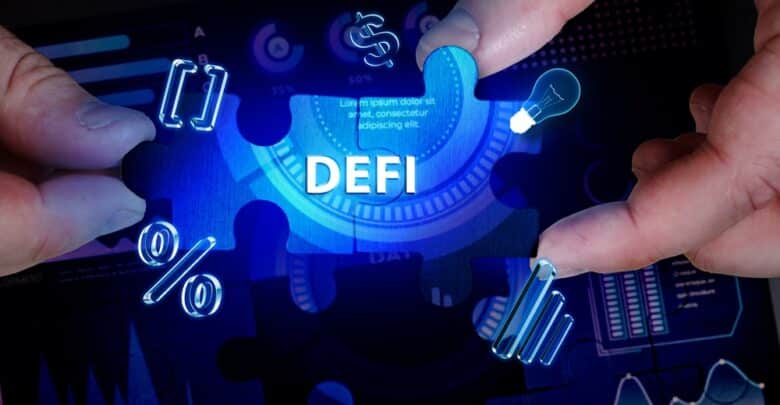Web3 Vs. DeFi – Main Differences Explained

Ethereum blockchain and its smart contract functionality led to the development of an infrastructure that further facilitated the introduction of Web3. Web3 has brought solutions to many problems faced by the users of Web1 and Web2. It has integrated smart contracts, decentralized computer applications, and distributed networks through blockchain technology.
Later on, the Ethereum network managed access to multiple protocols that could be utilized to gain access to a permissionless, secure, transparent, and open financial system. It was known as Decentralized Finance (DeFi), which kept the foundation of an entirely new decentralized financial system.
In this guide article, we will discuss the properties and working of both Web3 and DeFi. However, readers will mainly learn about their critical differences and the future of both.
What is Web3?
Bitcoin protocol was launched in 2009 and has been considered a great success. However, the limited utility of the Bitcoin network has also been an issue. As the Bitcoin network became popular among users, several new smart contract blockchains, such as the Ethereum network, were also created.
An array of decentralized finance applications and digital art movements exist in the Ethereum network. This network formed the basis of what we know today as Web3.
How Does Web3 Work?
The technological engagement of people, particularly in the financial sector, has changed with the internet’s development over time. These developments are commonly divided into Web1, Web2, and Web3 phases.
The internet’s first developmental phase is Web1, which stretches from the 1990s to the 2000s. In that era, websites were not very interactive and usually composed of HTML pages. In order to accommodate financial transactions there was no infrastructure to accommodate financial transactions.
In the next phase, Web2, the internet became more interactive. This phase of the internet was characterized by the consumption of online content, increased usage of social media platforms, and more development of mobile applications. In addition, people started carrying out fiat transactions over the internet.
However, several security threats arose during this time, such as cybercrimes, data privacy breaches, etc. People started fearing any interference from third parties, as they started selling their data without any consent.
This led to the development of Web3 aimed at solving the loopholes in Web2. It decreased the dependence of the public on companies and enterprises. Web3 provided a sense of ownership among individuals by introducing decentralization through blockchain technology. Web3 also led to the emergence of many cryptocurrencies, such as Bitcoin, multiple decentralized applications (DApps), and decentralized finance (DeFi).
Using decentralization and blockchain technology, Web3 gives users control and ownership of their data. Moreover, one can control who can access information and content.
What is DeFi?
Decentralized Finance (DeFi) is the financial interaction between any two parties without the involvement of any intermediate. It deploys blockchain technology and enables users to conduct peer-to-peer interactions to execute financial activities such as borrowing or lending, mortgages, loans, etc.
The main goal of decentralized finance is to create a secure, permissionless, and open-source ecosystem for the users without providing control to any central authority. Individuals can conveniently create decentralized applications, manage their transactions and assets and execute peer-to-peer exchanges through the network.
How Does DeFi Work?
The financial system operating independently without any mediating authority, such as a bank, is decentralized finance. Users can directly carry out financial transactions with each other using DeFi. Smart contracts govern peer-to-peer transactions allowing traders to lend and borrow loans.
Decentralized finance was developed to cater to the control and ownership of centralized authorities, such as banks and governing bodies, over the data and content of the users. However, DeFi allows its user to participate in financial activities without requiring any permission. In addition, it also eliminates the need to authorize transactions by any institution.
Components of DeFi
The most distinct property of DeFi is transparency. All participants in the system can have access to all happening around them. Some of the essential components of ensuring the transparency and security of DeFi are discussed below.
- Layer 1
All DeFi protocols, tokens, applications, and smart contracts are built on the blockchain or base network known as Layer 1. Ethereum, Bitcoin, Polkadot, and BNB Smart Chain have known examples of Layer 1 networks.
- Decentralized Exchanges
A platform allowing users to buy, sell or exchange digital assets without any mediator involved is known as a decentralized exchange. It does not require the involvement of any third party or centralized system to execute the transactions. Smart contracts have now replaced the role of centralized authorities in DeFi exchanges. Smart contracts can self-execute themselves using computer code.
- Aggregators and Wallets
The decentralized interfaces enabling users to manage their assets along multiple trading platforms through yield farming are known as aggregators. A few of the commonly known aggregators, 1inch and RocketX, are helping maximize profits for the traders and provide access to liquidity.
RocketX allows traders to swap different wallets only through a single click and receive tokens. Moreover, it allows navigation between both decentralized and centralized platforms.
- Decentralized Marketplaces
Without any involvement of a mediating body, users can utilize decentralized marketplaces to carry out peer-to-peer transactions. It also eliminates the requirement of any decentralized exchange.
Is DeFi a Part of Web3?
DeFi is an evolving financial system that is growing within Web3. It provides the users with new values and utility that do not exist in traditional financial systems.
Web3 has emerged as a new concept for the internet. It aims to make the internet fair and decentralized by deploying blockchain technology. It allows users to earn capital and increases control over their data and identity.
The prominent distinctive feature between DeFi and Web3 is their base. DeFi is built on smart contracts, while Web3 platforms are created on top of the internet itself. However, DeFi and Web3 are different perspectives but have multiple common interacting points.
They both have the similar goal of moulding the existing pattern of the internet and financial sector for the betterment of their users. Moreover, they are also striving to provide secure trading platforms for traders.
What are the Benefits DeFi is Gaining from Web3?
The decentralized and secure nature of DeFi is further enhanced by Web3 technology. It has made the financial system more transparent and accessible, thus building user confidence. As the hype of investing in crypto assets increases, more people want to participate in trading. For this purpose, they sell or purchase crypto assets or create and trade new crypto projects.
The increasing public interest further expedited the development of blockchain technology and Web3. However, there are a lot of innovations still to happen. Experts consider Web3 as the future of the internet, which could alter money’s actual purpose in the financial market.
One of the major advantages of Web3 is its capacity to handle a large volume of potential customers willing to support digital transactions and decentralized finance. The number of internet users is increasing each year.
Almost 63% of the total population on Earth, constituting about 5.07 billion people use the internet. Therefore, the number of people using the decentralized finance protocol will also increase as soon as people shift from Web2 to Web3.
In addition, the younger generation is becoming more used to life without cash as the popularity of digital assets for making payments is increasing. With the fast-changing technology, Web3 and DeFi will soon integrate into our daily lives in the future.
Comparison Between DeFi and Web3
Web3 has made the creation of an equitable internet possible through the implementation of blockchain technology. The actual aim of using the internet was to provide an accessible and secure medium to the users. However, this purpose has been neglected through the centralization of the internet. DeFi created a more transparent version of Web3 for its users. Some of the distinct properties between DeFi and Web3 are discussed below.
- Permissionless
No restriction is imposed on the participants to participate in these networks. The term permissionless refers to the same concept, as there are no barriers or limitations set to participate in trading.
However, the way of implementation and usage by the developers explain the significant difference between the DeFi and Web3 technologies. Blockchain technology keeps the basis of DeFi and allows its users to use several financial services without the involvement of any central authority.
Web3 is used broadly, containing DeFi and all other decentralized services, including the nonfungible tokens, decentralized applications, and DAOs under it.
- Decentralized
The ability of an entity to operate without any involvement of centralized authority is referred to as decentralization. Web3 and DeFi are both decentralized in nature. DeFi uses blockchain technology to carry out transactions without depending on centralized authorities such as banks. Similarly, Web3 aimed to develop a network free from any central control. For this purpose, it uses the peer-to-peer protocol to create a decentralized and open network.
- Custodial
DeFi protocols are usually non-custodial in terms of providing control to the users. The users have complete control over their funds and assets as they hold private keys to access them. On the other hand, depending on the particular application, Web3 can also be non-custodial. However, in some cases, third parties are provided with private keys, thus making it custodial.
- Interoperable
The ability of different blockchain networks to communicate is called blockchain interoperability. Multiple blockchains can easily exchange tokenized assets, data, and other technologies. Users can access the data stored centrally through different applications. All the decentralized financial services stored on the blockchain network are connected.
- Cryptographically Verifiable
The DeFi and Web3 services are designed in a way that they are invulnerable to any tampering activity. This is because the records are available on the blockchain that can be verified at any time through cryptography. It adds to the transparency and security of the networks. Moreover, it becomes difficult for anyone to manipulate the records on the chain.
- Governance and Economic Systems
Decentralized governance mechanisms and asset tokenization are used by both DeFi and Web3 networks to grow their economies. Many DeFi and blockchain users allow the users to participate and give opinions regarding future developments of the projects through the Proof of stake protocol.
Users can purchase digital assets for a minimal amount as one dollar. Moreover, these assets are fractional and can be further divided to earn profit. This has increased the interest among several users to invest in crypto who had to face multiple barriers to entering the crypto market.
Some Important DeFi Projects
Some of the critical DeFi projects that are facilitating the users are discussed below.
- Maker (MKR)
Maker is among the top major decentralized networks based on the Ethereum network. It is a decentralized autonomous organization (DAO) that assists traders in lending and borrowing crypto assets on multiple platforms.
- Curve Finance (CRV)
Curve Finance is a decentralized exchange platform that allows its users to exchange stablecoins with each other.
Some Important Web3 Projects
A few of the critical Web3 platforms are discussed below.
Helium is a decentralized network empowered by blockchain technology for IoT devices. It utilizes radio waves to transmit data by using a network of low-power wireless spots expanded worldwide. This data is then recorded on the blockchain network. In addition, the Proof of convergence consensus is used by the network that assists in the validation that the hotspots are providing proper network coverage.
A blockchain abstraction layer that helps in operating smart contracts linked globally. In addition to representing the correct combination of any two projects by applying the right technology, it also carries the capacity to expedite further development. Chainlink owns a beautiful worldwide community. Market experts consider it one of the best Web3 crypto assets that have the potential to take over Bitcoin in future.
Downsides of DeFi
Despite providing users with multiple benefits, there are certain drawbacks to using DeFi.
- The exploitation of Smart Contracts
Smart contracts are complex to be understood, which makes them more prone to be exploited by hackers. It may result in the users losing their funds permanently. Therefore, it is essential for one not to invest in trading more than one he cannot afford to lose.
- Unsecure Consumers
Decentralized finance usually is not regulated. Users may lose their unlimited funds if any bug or illicit activity happens. Moreover, the founders of most decentralized protocols are usually anonymous and have no proper legal authority operating over them.
- Losing Private Keys
There is usually a Web3 wallet required to access the decentralized protocols that are usually achieved through a private key. Therefore, the user may lose all his assets and funds if he loses the private key. In addition, sharing the private key with any external entity may prove dangerous.
Downsides of Web3
Although users greatly benefit from the services provided by Web3, some downsides of Web3 need to be addressed.
- Require High-Tech Devices
Several technologies, such as blockchain, artificial intelligence, and machine learning, empower Web3. Therefore, different technologies, such as semantic data and 3D visuals, are employed on the Web3 network. This purpose requires high-tech electronic devices to support enormous and complex data.
- Regulatory Issues
Decentralizing the internet through Web3 has made it more difficult to control and regulate. This increases the vulnerability of scams and cybercrimes.
- Easy access to Data
The private and public data is easily accessible to everyone using Web3, making it easier to manipulate the uploaded content.
What Does the Future Hold for DeFi and Web3?
The willingness of the public to adopt the DeFi and Web3 models and the continuous growth of blockchain technology will decide the future of both these networks. No one can predict the future; however, multiple positive aspects of the DeFi and Web3 models make the developers hopeful.
With the increasing development of new financial products and services that could prove competitive to the existing traditional networks, DeFi is moving towards more innovations. The decentralized exchanges, applications, yield farming, and stablecoins are all included in it. Moreover, the network also focuses on providing convenient accessibility and easy adoption to its users, which would assist in the further growth of the economic DeFi system.
On the other hand, Web3 has a pivotal role in the future development of the internet. Compared to centralized systems, several advantages are provided by the decentralized system to the users, such as increased security, ownership, and data privacy. In addition, an open and more equitable new generation of decentralized applications is said to be achieved with the speedy development of Web3 technologies.
Conclusion
Without a doubt, we can mention that the internet is among the major innovations the world has witnessed. It has allowed people to connect, share and communicate with each other through the global distribution of content and information. After Web1 and Web2, currently, Web3 is performing its duties to concentrate the world. In addition to connecting and exchanging content among people, it allows them to earn through it.
As Web3 is still evolving, several developments such as DeFi, nonfungible tokens and DAOs prove that the world will soon witness the complete decentralization of financial activities. Moreover, it will also create uncountable opportunities for users to earn capital.
Tokenhell produces content exposure for over 5,000 crypto companies and you can be one of them too! Contact at info@tokenhell.com if you have any questions. Cryptocurrencies are highly volatile, conduct your own research before making any investment decisions. Some of the posts on this website are guest posts or paid posts that are not written by Tokenhell authors (namely Crypto Cable , Sponsored Articles and Press Release content) and the views expressed in these types of posts do not reflect the views of this website. Tokenhell is not responsible for the content, accuracy, quality, advertising, products or any other content or banners (ad space) posted on the site. Read full terms and conditions / disclaimer.




